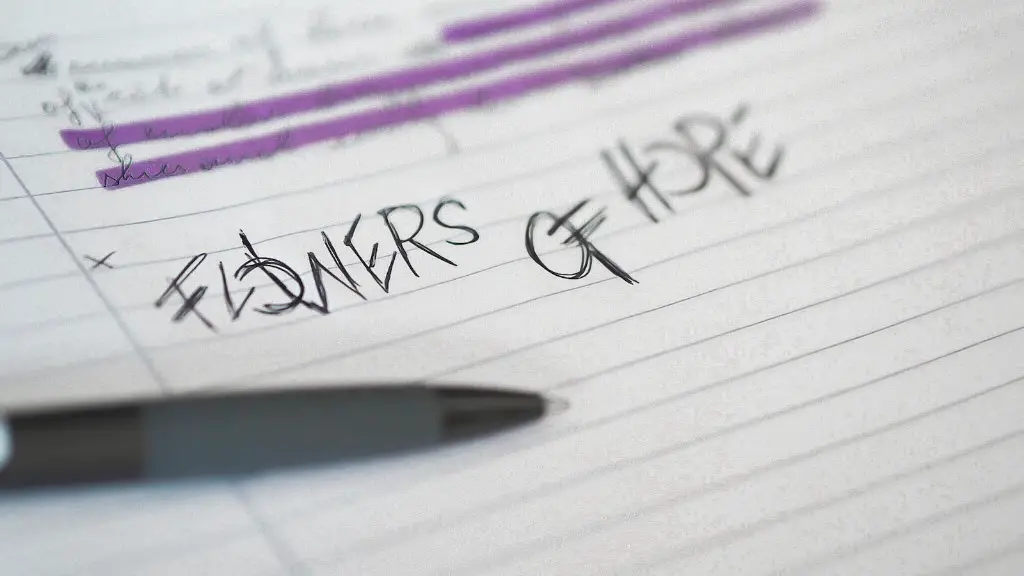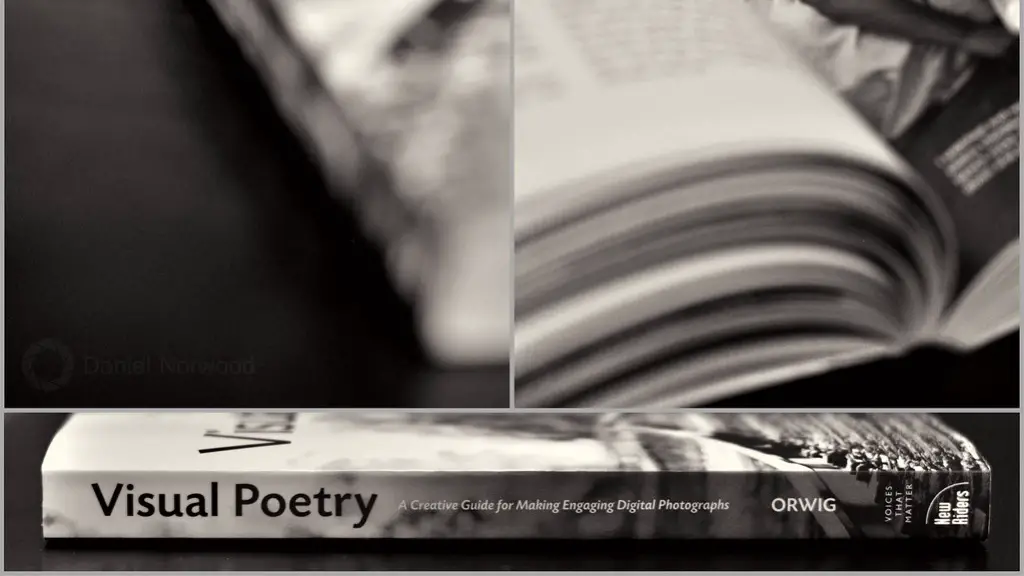When someone hears the phrase “content in poetry”, they may wonder what it means. Put simply, content in poetry is defined as the emotions, ideas, and images conveyed through the poet’s words. Poets create meaningful compositions through the use of language, the exploration of the deeper meanings in words, the structure of their poetry, and the various techniques employed to send their message. Content in poetry can provide insight into the emotions, feelings and messages the poet wishes to convey, and can offer a deeper understanding of the poem’s meaning.
Many poets use language as an expression of their thoughts and feelings. Whether it is through figurative language, descriptive language, or imagery, poets use words to communicate important ideas. For example, a poet may use metaphors to describe something in a unique way. By using different words, he may give the phrase a different meaning or connotation, allowing the reader to interpret the phrase in his own way. Furthermore, different words can evoke different emotions, which give the poem a deeper meaning. In this way, language plays a large role in how a poem’s message is expressed.
Another way in which poets explore the deeper meanings of their words is through the structure of their poetry. By using a specific form or pattern of words, poets can emphasize or downplay certain words to communicate a specific message to the reader. For instance, a poet may choose to use alliteration in certain parts of a poem, in order to stress the importance of that particular fragment. Alternatively, poets may use a specific meter or rhyme scheme to ensure that their poem communicates its expression in a more unified manner. By manipulating the structure of a poem, a poet can effectively use words to share a more profound message.
Moreover, poets have various techniques at their disposal to convey their message. For example, a poet may employ personification or use semantic fields to draw a certain comparison. By painting vivid mental images for the reader to visualize, the poet is further allowed to express himself. Furthermore, poets may even break the expected rules of syntax, allowing them to explore new ways of conveying their ideas. By manipulating the traditional structure of language, poets can push the boundaries of their expression, while making their writings more engaging and relatable to their readers.
Overall, content in poetry is the set of emotions, ideas, images, and messages expressed by the poet through his or her language, structure, and techniques. Poets use language, explore the deeper meaning of words, and employ various techniques to create powerful compositions. By doing so, they are able to share their emotions, feelings, and philosophies in an expressive and engaging manner.
Value of Content in Poetry
The content in poetry has great value for the writer and for the reader. It is a way for the writer to present their personal experiences and thoughts, feeling secure enough to explore their ideas with the reader. The writer can take risks and express their inner thoughts, by creating something of beauty and engage the reader in an environment of open discussion and an atmosphere of artistic expression.
For the reader, content in poetry can offer a completely different perspective than the one they may be accustomed to. It provides an opportunity to explore unfamiliar topics, by observing how the writer has expressed their ideas. It allows the reader to appreciate the poet’s unique way of seeing the world and to appreciate what the poet is trying to say. Furthermore, readers can learn from the sensitivity and precision of the words used in the poems, and their meanings and messages.
Essentially, content in poetry can teach both the writer and the reader the various nuances of language and communication, and can bring out the best and brightest of each person. Creating poetry is an act of courage, as the poet is bravely venturing into the unknown and sharing his or her experiences with the world. Therefore, content in poetry can become a valuable tool of self-expression and reflection and can serve to broaden the horizons of both the writer and the reader.
Unique Aspects of Storytelling
The unique aspect of storytelling in poetry is that it adds a new flavor to content found in the work. Poetry is rich in storytelling because the language and structure of the piece allow the writer to create a vivid and captivating narrative. For example, a poet may use strong imagery, metaphor and personification to accomplish this. This can provide readers with a more immersive experience, as the poet can create a world and tell an engaging story within a matter of lines.
Furthermore, storytelling can provide a deeper understanding of the poem as a whole. By connecting the different parts of a poem together, the reader is able to connect the dots and create a story from the poem. This makes the poem more meaningful, as it draws the reader in and allows them to engage with the poem at a more intimate level. Therefore, storytelling can be an effective tool that poets can use to take their poem to another level of expression and understanding.
Additionally, storytelling can be used to convey important messages and themes. Poets can use the story they create through their poem as a means of exploring social, moral, and political topics. By creating an engaging narrative, they can explore different ideas and perspectives while putting their own unique spin on them. This allows the poet to explore topics which are often too uncomfortable or taboo to tackle head-on. By using their own personal narrative and expertise, they can provide a unique insight into these topics and help their readers to expand their understanding.
The Role of Poetry in Today’s Society
At present, poetry is playing an ever-growing role in society. It is used to express feelings and opinions, challenge social and political beliefs, and bridge the gap between different cultures. Poetry often provides a safe place for people to be vulnerable, to share their experiences, and to start meaningful conversations about reality. Furthermore, it can be used to put a more creative spin on tired topics and to touch on issues which people struggle to talk about in everyday conversations.
In the era of social media and digital technology, poetry is becoming increasingly accessible. With its growing presence, it is becoming more and more popular, as people find comfort in its words and discover its potential. This is reflected in the numerous poetry slams and open mic nights that are popping up in all kinds of locations, and in the immense variety of websites and social media platforms dedicated to sharing and discussing poetry.
Moreover, poets often collaborate with other writers and use multimedia to engage their readers. Using podcasts, YouTube videos, and other forms of media, they are able to promote their work and engage readers on a more intimate level. By doing this, they are connecting more people to the world of poetry, and thus increasing its presence in society.
Purpose of Content in Poetry
Poetry has the power to inspire, to motivate, and to touch the heart of its readers. Content in poetry is not only about the words within the poem, but also about the feelings and emotions that the poem is trying to evoke. Poetry is a way for people to express their deepest thoughts and feelings in a safe and creative way. By combining words with imagery, metaphors and stories, the poet can share his or her story and express emotions that are difficult to verbalize or express without poetry.
Furthermore, content in poetry can provide solace and comfort to those who need it. Poetry can be a source of healing, as the poet can explore his or her own thoughts, feelings, and experiences while seeking to understand others better. For many, poetry is a way of connecting with the world and finding a sense of belonging. It is a safe place to explore and express emotions in a safe environment.
In sum, content in poetry is incredibly powerful, as it can be used to share stories, explore emotions, and find connections between different people. It gives poets the opportunity to take risks and express their ideas in a creative and meaningful way, while helping readers to gain a more intimate understanding of both the writer and the poem. Ultimately, content in poetry is a powerful expression of self and of humanity, and can be a source of solace, comfort, and inspiration to both the writer and the reader.
Techniques Used to Create Content in Poetry
When creating content in poetry, the poet must consider what techniques can be used to effectively express their thoughts, feelings, and perspectives. One technique a poet can use is the use of imagery and symbolism. By creating vivid mental images, the poet can use fewer words to convey more meaning to the readers. It also allows them to paint a clearer picture in the reader’s mind, making the poem more engaging and relatable.
Additionally, poets may use metaphors, similes, and juxtapositions to convey different ideas. This allows them to explore multiple topics within one poem, as each technique carries its own distinct meaning. Metaphors and similes can also be used to make complex topics more understandable and to make comparisons between different ideas. By carefully selecting which technique to use in which lines, the poet can effectively communicate his or her message.
Moreover, poets may choose to use personification and alliteration to add depth to their poetry. Personification can be used to humanize inanimate objects, allowing the poet to bring his or her ideas to life. Similarly, alliteration can be used to emphasize a certain phrase or sentiment and to create a rhythm within the poem. This is particularly useful when exploring a particular topic, as it allows the poet to stress the importance of his or her words in a compelling and powerful way.
Overall, content in poetry is an important tool for expressing emotion and ideas. Poets must carefully consider which techniques to use to effectively tell their stories. By using techniques such as imagery, symbolism, metaphors, similes, and personification, the poet can create a vivid and meaningful narrative for the reader to experience.
Feedback from the Community
Nowadays, the feedback from the community concerning content in poetry is largely positive. Poetry has become popular in many different circles of society and is often used to express oneself and to enter meaningful discourse with others. Furthermore, many readers appreciate how the poet expresses his or her thoughts in such a concise and poetic manner, often creating absolutely beautiful pieces. Additionally, many people find that poetry provides a unique perspective and alternative to discussing certain topics.
Overall, the feedback from the community indicates that content in poetry is highly valued and appreciated. As a form of expression, it is seen as one of the most powerful ways to express oneself in today’s society. Furthermore, it has become increasingly accessible and popular, as more and more people are embracing the form and discovering its potential. This is reflected in the growing number of people who create and share their poetry with the world.
Advice for Poets
Creating content in poetry can often be a daunting task, as it requires a lot of thought and creativity. That being said, there are a few tips for poets that may help them to write something meaningful and powerful. Firstly, it is important for poets to be creative and to push themselves to think outside of the box. Experimenting with different language, structure, and techniques can be a great way to create something unique and meaningful.
Additionally, it is important to be brave and express one’s thoughts and feelings, as this is what will move the reader. It can be helpful to be vulnerable and share experiences that may be difficult to talk about openly, as this can make the poem more relatable and engaging. Furthermore, gathering feedback from others can provide valuable insights into how the poem is received, and can help the poet to make adjustments before publishing the piece.
In conclusion, content in poetry is an incredibly powerful tool for expression and communication. By understanding the different elements of poetry and the techniques used to create meaningful content, poets can create powerful narratives that will move and engage their readers. As poetry has become an increasingly popular form of expression, people can explore a variety of topics and perspectives that may have previously been too uncomfortable to talk about openly. As such, content in poetry is a valuable tool for both the writer and the reader, and can be a source of solace, healing, and inspiration.





